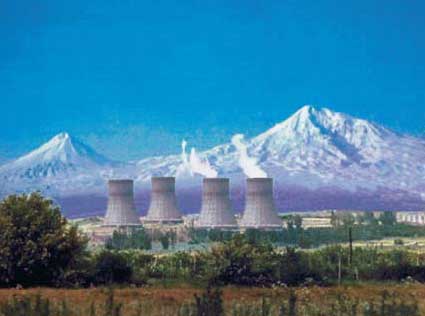


ArmInfo. The first block of the Armenian nuclear power plant will be decommissioned. The draft of the relevant law was approved at a government meeting on October 12.
According to the Minister of Energy Infrastructures and Natural Resources of Armenia Ashot Manukyan, the government's decision is based on Armenia's international obligations, especially the International Atomic Energy Agency (IAEA). Since February 1, 1989, both power units of the Armenian nuclear power plant were stopped, and on November 5, 1994 the second power unit of the station was re-commissioned, continuing to produce electricity at the present time. Tens of millions of dollars were sent to the second block, as a result of which today the level of its reliability and security is at the highest level. "This is also evidenced by the reports of the IAEA," the minister said, adding that the results of European Union stress tests testify to the reliability of the second block.
At the same time, Ashot Manukyan continued, the first block, de jure, being in operation, de facto does not produce electricity. Its further exploitation is impossible both in terms of safety and reliability. In 2014, the Armenian government decided to extend the life of the second power unit for a period of 10 years. In the process of implementing this program, it became clear that some suitable elements of the first block can be used on the second. Thus, the minister continued, the first block can become a donor for the second block, which will reduce the cost of implementing the program to extend the life of the power unit N2. According to the draft law, the decommissioning of the first power unit of the ANPP will last 40 years. $ 310 million will be allocated for the implementation of the program. To this end, an extrabudgetary fund will be created in the RA Ministry of Finance, which will finance the project. In the first three years, the investment in the project will be 6 million euros, in the next 10 years - 70 million euros, and in subsequent years - over 163 million euros.
Earlier, in an interview with ArmInfo, Advisor to the Minister Areg Galstyan informed that at the end of next year an updated strategy for the decommissioning of the first power unit of the Armenian NPP will be developed and approved. According to him, such a strategy with the EU funds was developed 8 years ago. "But a lot of time has passed since then, the methodology and approaches have changed, which requires updating the strategy." Taking into account the fact that the second unit will be operated before the end of 2026, it was necessary to decide on the first block, based on the updated strategy, and the final cost will be determined Of course, there is only one thing, the funds will not be spent immediately, "the minister's advisor said. At the first stage, insignificant financial resources will be used. During this period, it is planned to dismantle the equipment of the second circuit of the first unit, which is not contaminated. After the first stage, the preparatory work for the second stage will begin. Here it will be a question of dismantling the equipment of the first circuit of the unit, which includes a reactor installation.
The Armenian nuclear power plant consists of two units with Soviet (Russian) WWER reactors. The first unit was commissioned in 1976, the second - in 1980. In March 1989, after the Spitak earthquake, which killed 25 thousand people, the station's work was stopped. In November 1995, in connection with the most acute energy crisis, the second power unit of the station with a capacity of 407.5 MW was involved. In March 2014, the Armenian government decided to extend the lifetime of the second power unit by 10 years - until the year 2026.
The project is coordinated by the subsidiary structure of the State Corporation Rosatom - JSC Rusatom Service. Completion of work is planned for 2019. The Government of the Russian Federation allocated a $ 270 million state export loan to Armenia and a $ 30 million grant for these purposes. In March 2015, the Joint Coordination Committee (JCC) was established to implement the program. So far, there have been five meetings of the JCC.